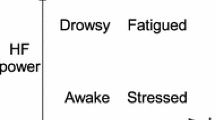Abstract
Drivers have to drive their vehicle safely by properly using steering, throttling, and braking controls. However, drivers do not always maintain their concentration on managing their vehicles. The primary causes of driver inattention are distracting activities and drowsiness. Such driver inattention is thought to be one of the major causes of traffic accidents, and so the objective of the present study is to develop a new method for detecting driver inattention from fluctuations in vehicle operating data. Steering and throttle operations while driving were measured by acceleration sensors and respiration rhythm and an electrocardiogram were measured as physiological indices. The result of correlation between the estimative value, peaks and exponent values of frequency characteristics of vehicle operating data, and physiological indices, an association of sympathetic nervous system activation was indicated. The performance of detecting normal state, under cognitive stress state, and drowsy state by this method was an average correct discriminatory rate of 70 %.





Similar content being viewed by others
References
Klauer SG, Dingus TA, Neale V et al (2006) The impact of driver inattention on near-crash/crash risk: an analysis using the 100-car naturalistic driving study data. Techn Rep National Highway Traffic Safety Administration, DOT HS 810:594
Borghini G, Astolfi L, Vecchiato G, et al (2012) Measuring neurophysiological signals in aircraft pilots and car drivers for the assessment of mental workload, fatigue and drowsiness. Neurosci Biobehav Rev (In press)
Rodriguez-Ibañez N, García-Gonzalez MA, de la Cruz MAF et al (2012) Changes in heart rate variability indexes due to drowsiness in professional drivers measured in a real environment. Comput Cardiol 2012:913–916
Nozawa A, Mizawa H, Mizuno T et al (2006) Evaluation of the driver’s mental workload by conversational form based on facial skin thermal image analysis. IEEJ Trans Sens Micromach 126(8): 412–418
Sakamoto R, Nozawa A, Tanaka H et al (2006) Evaluation of the driver’s temporary arousal level by facial skin thermogram-effect of surrounding temperature and wind on the thermogram. IEEJ Trans Electron Inf Syst 126(7): 804–809
Forsman PM, Vila BJ, Short RA et al (2013) Efficient driver drowsiness detection at moderate levels of drowsiness. Accid Anal Prev 50: 341–350
Mortazavi A, Eskandarian A, Sayed RA (2009) Effect of drowsiness on driving performance variables of commercial vehicle drivers. Int J Automot Technol 10(3): 391–404
Eskandarian A, Mortazavi A (2007) Evaluation of a smart algorithm for commercial vehicle driver drowsiness detection. Intell Vehicles Symp, IEEE, pp 553–559
McDonald AD, Schwarz C, Lee JD et al (2012) Real-time detection of drowsiness related lane departures using steering wheel angle. Proceedings of the Human Factors and Ergonomics Society Annual Meeting 56(1): 2201–2205
Saito K, Uchida M, Nozawa A (2013) Control of handwriting based on Rhythm Perception. IEEJ, Transactions
Komatsu T, Miyake Y (2003) Time-series analysis of anticipatory behavior in synchronization tapping task. Trans Soc Instrument Control Eng (Transactions of SICE) 39(10): 952–960
Hausdorff JM, Peng CK, Ladin Z et al (1995) Is walking a random walk? evidence for long-range correlation in stride interval of human gait. J Appl Physiol 78: 349–358
Nozawa A, Uchida M, Mizuno T (2013) Analysis of 1/ f fluctuation of keystroke dynamics and heart rate variability. Noise Fluct, IEEE, pp 1–4
Author information
Authors and Affiliations
Corresponding author
Additional information
This work was presented in part at the 19th International Symposium on Artificial Life and Robotics, Beppu, Oita, January 22–24, 2014.
About this article
Cite this article
Bando, S., Nozawa, A. Detection of driver inattention from fluctuations in vehicle operating data. Artif Life Robotics 20, 28–33 (2015). https://doi.org/10.1007/s10015-014-0191-8
Received:
Accepted:
Published:
Issue Date:
DOI: https://doi.org/10.1007/s10015-014-0191-8




